

Wendy L Schultz sur Twitter : "How #SpaceX + #Boeing keep NASA #astronauts safe better safety = civilian spaceflight sooner. How SpaceX and Boeing plan to keep NASA astronauts safe. Nearly a month after SpaceX's Falcon 9 rocket disintegrated en route to the International Space Station, CEO Elon Musk announced what brought the vehicle down: a faulty steel strut, just 2 feet long and 1 inch thick.
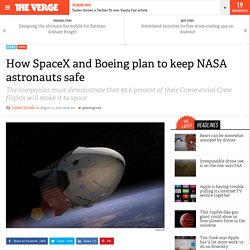
It was one of thousands of struts holding down the helium pressure valves inside the rocket's liquid oxygen tank; when it snapped, it released too much helium, causing the tank — and then the rocket — to burst. Even the smallest oversight can be catastrophic in spaceflight. Fortunately, no astronauts were aboard the doomed vehicle — only food, water, and cargo were lost. But astronauts will be aboard that same rocket very soon. SpaceX and Boeing are currently developing crew transportation modules that will ferry US astronauts to and from the ISS. Wendy L Schultz sur Twitter : "In case you wondered: Why the #Vatican doesn’t think we’ll ever meet an #spacealien Jesus. Why the Vatican doesn’t think we’ll ever meet an alien Jesus. Pope Francis waves upon arrival at the Ecuadorean Air Force Base in Guayaquil on July 6.
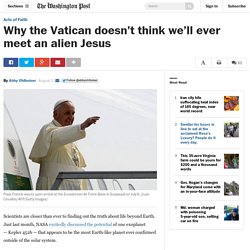
(Juan Cevallos/AFP/Getty Images) Scientists are closer than ever to finding out the truth about life beyond Earth. Just last month, NASA excitedly discussed the potential of one exoplanet — Kepler 452b — that appears to be the most Earth-like planet ever confirmed outside of the solar system. Wendy L Schultz sur Twitter : "#Space is suddenly getting interesting again, but it may be all for nothing. Space is suddenly getting interesting again, but it may be all for nothing. Comment An artist's impression of one possible appearance of the planet Kepler-452b, the first near-Earth-size world to be found in the habitable zone of a star that is similar to our sun Photo: Reuters After decades of going boldly nowhere in low Earth orbit, Man, or rather his robotic emissaries, have made some startling discoveries in our Solar System.
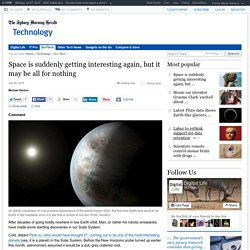
Cold, distant Pluto is - who would have thought it? Neil deGrasse Tyson's answer to innovation stagnation: a space race to Mars. Neil deGrasse Tyson sees a role for space in stimulating our terrestrial economy.

Photo: Supplied A voyage to Mars: getting there would be half the fun. Space Martini Glass Kickstarter - 3D Printing Industry. An Astounding History of Scientific Space Art from the Past 200 Years. Kinja is in read-only mode.

We are working to restore service. The second painting immediately reminded me of the cover art from Frederick Pohl's Gateway (first hardcover edition). I googled John Berkey, and sure enough, he painted that cover. Probe makes historic comet landing. 12 November 2014Last updated at 11:10 ET Philae (shown in this artist's impression) should offer fresh insights into the origins of our Solar System European robot probe Philae has made the first, historic landing on a comet, after descending from its mothership.
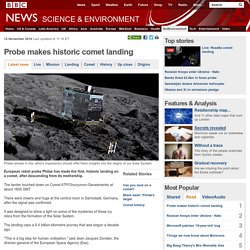
Zhan Wang's animation shows how lunar minerals could affect China. Zhan Wang's animation shows how lunar minerals could affect China. Abiogenesis (Short Film) The 2020 Mars Rover Has Awesome Toys. Are they discussing possible landing sites yet?

They are discussing them. What a space city would actually look like in real life. New ion engine could reach Mars in 39 days. Last week, as the world celebrated the first lunar landing, Apollo 11 astronauts Buzz Aldrin and Michael Collins both called for NASA to make Mars its next goal.
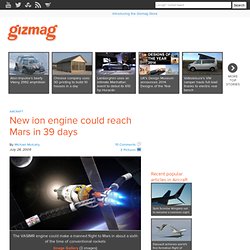
But the chemical propulsion system that took them to the moon would take six months, at least, to get a man to Mars and cost hundreds of billions of dollars. However, a new ion plasma rocket being developed by another former astronaut, Franklin Chang-Diaz, could potentially reach Mars in just 39 days using a fraction of the fuel. The problem with traditional rockets is that they’re terribly inefficient. About 90% of a mission’s initial weight is fuel, most of which is burned up escaping earth’s gravitational pull. After that, a traditional rocket could only slowly coast to Mars. Warp drive looks more promising than ever in recent NASA studies. "Interstellar travel may still be in its infancy, but adulthood is fast approaching, and our descendants will someday see childhood's end.
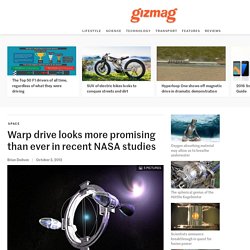
" The Starflight Handbook The first steps towards interstellar travel have been taken, but the stars are very far away. Voyager 1 is about 17 light-hours distant from Earth and is traveling with a velocity of 0.006 percent of light speed, meaning it will take about 17,000 years to travel one light-year. Fortunately, the elusive "warp drive" now appears to be evolving past difficulties with new theoretical advances and a NASA test rig under development to measure artificially generated warping of space-time. The warp drive broke away from being a wholly fictional concept in 1994, when physicist Miguel Alcubierre suggested that faster-than-light (FTL) travel was possible if you remained still on a flat piece of spacetime inside a warp bubble that was made to move at superluminal velocity.
Share a link. Russia Severs Space-Science Ties With U.S. In A Curt Breakup Tweet. Blog - Students Design Space Habitats, Tech for NASA. SpaceHabs: One man's architectural vision for colonizing Mars. With a projected settlement date of 2025, the Mars One project has received over 200,000 applications for the one way trip to the Red Planet.
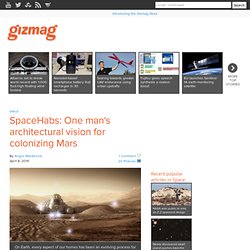
But creating a living, sustainable community on the distant planet for the select inhabitants will require not only unique technological and engineering solutions, but also novel architectural systems. Bryan Versteeg is a conceptual designer who’s been working with the Mars One team in anticipation of the planet’s eventual colonization. View all. NASA unveils a gorgeous new gallery of celestial images. Muslims 'warned in Fatwa not to live on Mars' A look inside the gorgeous world of "Dark Data" Interactive Infographic: The Search For Other Earths. Scientists turn table salt into forbidden compounds that violate textbook rules. In the field of exotic new materials, we've examined one of the strongest ones and another declared to be impossible; scientists now report creating "forbidden" materials out of ordinary table salt that violate classical rules of chemistry.
Not only does the development challenge the theoretical foundation of chemistry, but it is also expected to lead to the discovery of new exotic chemical compounds with practical uses and shed light on the deep interiors of planets. The international team of researchers led by Artem R. Nasa says Mars mystery rock that ‘appeared’ from nowhere is ‘like nothing we’ve ever seen before’ - Science - News. Experts said they were "completely confused" by both the origins and makeup of the object, which is currently being investigated by Opportunity's various measuring instruments. Astronomers noticed the new rock had "appeared" without any explanation on an outcrop which had been empty just days earlier. The rover has been stuck photographing the same region of Mars for more than a month due to bad weather, with scientists at the Jet Propulsion Laboratory (JPL) in California monitoring the images it sends.
Nasa issued a Mars status report entitled "encountering a surprise", and lead Mars Exploration rover scientist Steve Squyres told a JPL event it seems the planet literally "keeps throwing new things at us". Astronaut gut reaction: The microbiome in space - health - 16 January 2014. GOING to space changes a person. But humans aren't the only space travellers we need to consider: microbes can change after just a few days without gravity. Now scientists worry that the bugs astronauts bring with them in their guts may turn traitor in space.
The human body isn't just one organism, but an entire community teeming with millions of microbes, so there's a whole community of new questions that spacefarers need to think about. In a report released last week, scientists at the US National Academies highlighted the extent of our ignorance about the way microbes behave in space, and how best to treat astronauts who get sick.
The report cited studies showing that Salmonella typhimurium, known for causing food-borne illness, can change its genome to become more virulent after just a few days in space. Astronaut gut reaction: The microbiome in space - health - 16 January 2014. GOING to space changes a person. But humans aren't the only space travellers we need to consider: microbes can change after just a few days without gravity.
Now scientists worry that the bugs astronauts bring with them in their guts may turn traitor in space. The human body isn't just one organism, but an entire community teeming with millions of microbes, so there's a whole community of new questions that spacefarers need to think about. Space hotelier Bigelow wants capitalists to FIGHT comm-MOON-ist takeover. Bigelow Aerospace, sellers of inflatable bubble habitats for infinity and beyond, is filing for an amendment to the 1967 Outer Space Treaty to allow private individuals to own sections of the Moon.
"No one 'anything' should own the moon, but yes, multiple entities, groups, individuals, they should have the opportunity to own the Moon," company founder Robert Bigelow told CNBC. The Outer Space Treaty, first created by the UK, US and Soviet governments in 1967 and administered by the UN, is the basis of today's space law and has 102 signatories. Article Two states: "Outer space, including the Moon and other celestial bodies, is not subject to national appropriation by claim of sovereignty, by means of use or occupation, or by any other means. " ZA architects designs buildings for Mars. NASA to Use Giant 3D Printing Spider Robots to Construct Huge Spacecraft. It has always been theorized that the construction of large spacecraft would have to be done in orbit. NASA to Use Giant 3D Printing Spider Robots to Construct Huge Spacecraft. Gorgeous Glimpses of Calamity. Untitled. Self-replicating alien probes could already be here. Voyager 1 Discovers Bizarre and Baffling Region at Edge of Solar System.
A model of the solar system’s edge using recent data. Voyager 1′s latest findings will likely rewrite this image, as soon as scientists figure out exactly what they mean. How NASA might build its very first warp drive. I want to see this work as much as anyone else on io9, but every time I read an article on warp drive, I expend so much mental energy trying to wrap my head around the concept that my entire left hand side goes numb. Somewhere along the line my understanding of concepts such as the nature of Spacetime is deficient. 2013 June 12 - All of Mercury. Astrogarden Rover: How Can We Design a Garden for Mars? With incredible advances in space exploration, the idea of harvesting crops and planting gardens in space is leaving the realm of science fiction and becoming a reality.
The New Universe and the Human Future.
Scientists Search for Saturn's Northern Lights. Worlds Away From Here. The Helical Model – vortex solar system animation. First space tourist plans to make trip to Mars in 2018. 21st Century Waves » State of the Wave: 10 Space Trends for 2013 — Featuring the Approach of the New International Space Age. Apophis May Destroy Some of Earth's Satellites In 2029. Golden Spike announces plans for commercial lunar exploration. Will a Secret Private Manned Mission to the Moon Be Announced This Week? To Infinity and Beyond! Space Colony Art from the 1970s. Mars Curiosity rover finds radiation levels on Mars safe for humans. Engineer proposes $1 trillion USS Enterprise. News and information about meteor showers, solar flares, auroras, and near-Earth asteroids.
1859's "Great Auroral Storm"—the week the Sun touched the earth. Boffins bone up on rover skills as Curiosity speeds to Mars. James Cameron, Google Founder Back Space-Mining Venture. Social Foundations of Human Space Exploration. Japan Will Have a Space Elevator by 2050. Stunning Photos of Solar Flares & Sun Storms. A year in space: 30 pictures of Earth taken from the International Space Station in 2011. How The Biggest Solar Storm Since 2005 Is Going to Affect You.